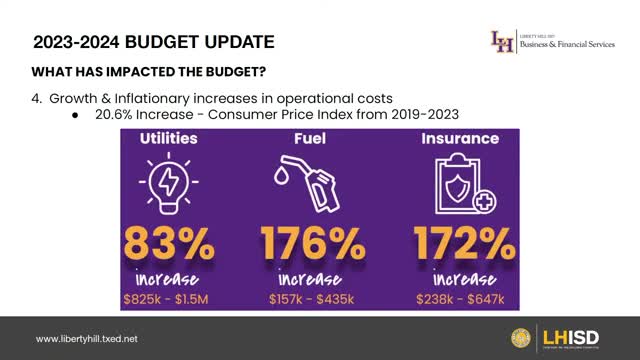Liberty Hill ISD faces budget crisis amid soaring costs
August 16, 2024 | LIBERTY HILL ISD, School Districts, Texas

This article was created by AI summarizing key points discussed. AI makes mistakes, so for full details and context, please refer to the video of the full meeting. Please report any errors so we can fix them. Report an error »

In a recent meeting, the Liberty Hill Independent School District (ISD) board addressed significant financial challenges stemming from inflation and rapid growth. The consumer price index has surged by 20.6% from 2019 to 2023, with utilities rising by over 83%, fuel costs increasing by 176%, and insurance costs climbing by 172%. Despite these pressures, the district has not adjusted its basic allotment.
The board discussed two key tax rates: the maintenance and operation (M&O) tax rate, which funds daily operations, and the interest and sinking (INS) tax rate, dedicated solely to debt repayment. The combined tax rate for taxpayers has been affected by state-mandated tax rate compression, which has reduced the M&O rate by 17.5 cents in the past year alone.
New tax laws have further complicated the district's financial landscape. The homestead exemption has increased from $25,000 to $100,000, resulting in reduced property tax collections without full compensation from the state. Additionally, a 20% cap on non-homestead properties has led to further revenue losses, with no state support to offset these declines.
The board is considering a proposal to increase the tax rate by $0.06 to address a projected budget deficit of $7.5 million, which could be reduced to $2.9 million with the proposed increase. This adjustment would allow for salary raises for teachers and staff, a critical factor in retaining talent amid competitive hiring conditions in surrounding districts.
If approved, the new tax rate would result in an estimated annual tax increase of $217 for a median home valued at $462,000. The board emphasized that the financial challenges faced by Liberty Hill ISD are reflective of broader issues affecting public education statewide.
The district has implemented $2 million in budget cuts, including staff reallocations and frozen positions, but continues to face rising operational costs due to student growth, which is expected to exceed 9,600 students in the upcoming year. The board is also required to address recapture payments to the state, which could further strain the budget.
Overall, the district's budget is projected to grow by 21% due to inflation and increased enrollment, with a significant portion of expenditures dedicated to staff salaries and benefits. The board's decisions in the coming weeks will be crucial in navigating these financial challenges while maintaining educational quality for students.
The board discussed two key tax rates: the maintenance and operation (M&O) tax rate, which funds daily operations, and the interest and sinking (INS) tax rate, dedicated solely to debt repayment. The combined tax rate for taxpayers has been affected by state-mandated tax rate compression, which has reduced the M&O rate by 17.5 cents in the past year alone.
New tax laws have further complicated the district's financial landscape. The homestead exemption has increased from $25,000 to $100,000, resulting in reduced property tax collections without full compensation from the state. Additionally, a 20% cap on non-homestead properties has led to further revenue losses, with no state support to offset these declines.
The board is considering a proposal to increase the tax rate by $0.06 to address a projected budget deficit of $7.5 million, which could be reduced to $2.9 million with the proposed increase. This adjustment would allow for salary raises for teachers and staff, a critical factor in retaining talent amid competitive hiring conditions in surrounding districts.
If approved, the new tax rate would result in an estimated annual tax increase of $217 for a median home valued at $462,000. The board emphasized that the financial challenges faced by Liberty Hill ISD are reflective of broader issues affecting public education statewide.
The district has implemented $2 million in budget cuts, including staff reallocations and frozen positions, but continues to face rising operational costs due to student growth, which is expected to exceed 9,600 students in the upcoming year. The board is also required to address recapture payments to the state, which could further strain the budget.
Overall, the district's budget is projected to grow by 21% due to inflation and increased enrollment, with a significant portion of expenditures dedicated to staff salaries and benefits. The board's decisions in the coming weeks will be crucial in navigating these financial challenges while maintaining educational quality for students.
View full meeting
This article is based on a recent meeting—watch the full video and explore the complete transcript for deeper insights into the discussion.
View full meeting
